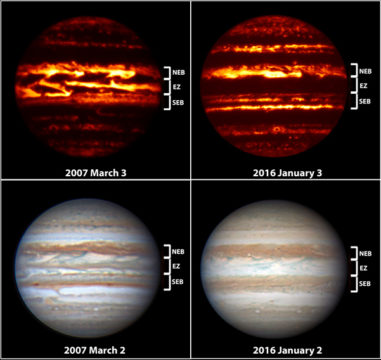Astronomers have identified a periodic clearing at the gas giant's equator; amateurs may have spotted the change at the end of 2018.
Planetary scientists have identified a recurring weather pattern at Jupiter's equator, with the help of NASA and amateur astronomers.

The planet's familiar stripes, including bright zones and ruddy belts, provide wonderful views through most any telescope. The patterns are known to shift and fade over poorly understood timescales. But in research recently published in Geophysical Research Letters, a team of scientists used data from NASA’s Infrared Telescope Facility on top of Maunakea, Hawai'i, to show evidence of a recurring cycle. Every so often the thick, white clouds at the equator disperse, revealing warmer regions usually hidden from view.
Comparing these infrared results to a large database spanning more than four decades of observations, scientists have been working to understand the forces shaping these gargantuan weather changes on the solar system’s largest planet. They found that these infrared clearings closely correspond to the rare times when Jupiter's equatorial zone, which usually appears white at visual wavelengths due to an upper layer of ammonia clouds, turns a distinctly yellowish-brown. The change indicates that the white ammonia clouds have dissipated.
"Jupiter’s equator is normally completely clouded over, appearing dark in the infrared because those cold ammonia clouds appear in silhouette against Jupiter’s warm internal glow," notes Arrate Antuñano (University of Leicester, UK), who led the study. "Those thick clouds make the equator look white through a visible telescope."
Coauthor Leigh Fletcher (also at the University of Leicester) adds, “Professional astronomers have been tracking Jupiter’s infrared emission for decades. Only by putting all of these observations together, from a wide variety of instruments over more than three Jupiter years (three decades on Earth) did we begin to spot a pattern.”
What the scientists saw was that the equatorial clouds vanished completely every six or seven years. Those disturbances each lasted for 12 to 18 months. "We saw spectacular examples in 1973, 1979, 1992, 1999 and 2006,” Fletcher notes.
The scientists expected to see similar events in 1985 and 2013, but although the brownish equatorial colors were apparent, the clouds didn’t clear completely at those times. Weather — whether here or on another world — remains unpredictable.
"As usual, Jupiter is reluctant to give up all its secrets at once," says Glenn Orton (NASA JPL). "It seems that this six- to seven-year pattern isn’t perfect, and sometimes we don’t see a complete cloud-clearing disturbance."
But what's exciting about this work, is that the pattern seen over the last few decades suggests another cloud-clearing event is due soon, perhaps as early as this year. Jupiter emerged from solar conjunction at the end of 2018, and it appears the clearing was already underway late in the year. Dedicated Jupiter observers, including Christopher Go, have already confirmed that the brown color of the equatorial zone has continued in January 2019.
What Will Juno See?
The periodic cloud-clearing could have some surprising implications for Juno, which has been exploring Jupiter's atmosphere and magnetosphere since July 2016.
Juno's microwave radiometer can peer beneath Jupiter's clouds, and has revealed a deep column of ammonia gas rising at the equator and condensing to form white clouds. It will be interesting to see how the plume changes with this new equatorial disturbance event.
Astronomers today confirm that the current event is indeed a full-blown clearing, so be on the watch for interesting occurrences in this area as Jupiter rises higher each morning and will soon be well-placed for good observations.
 0
0









Comments
You must be logged in to post a comment.